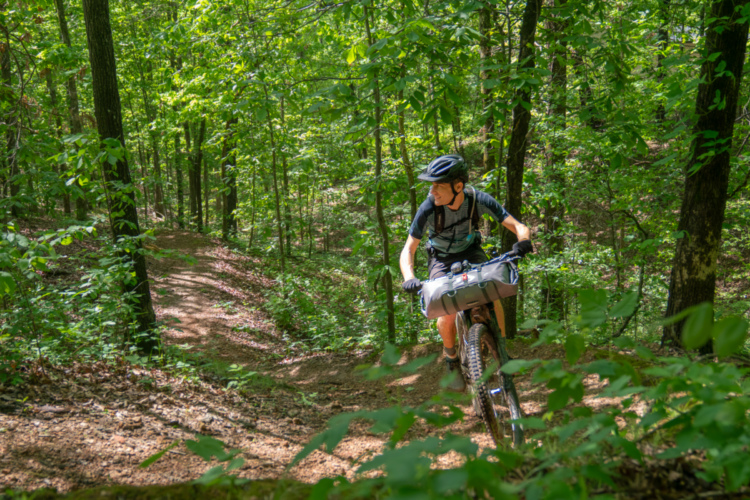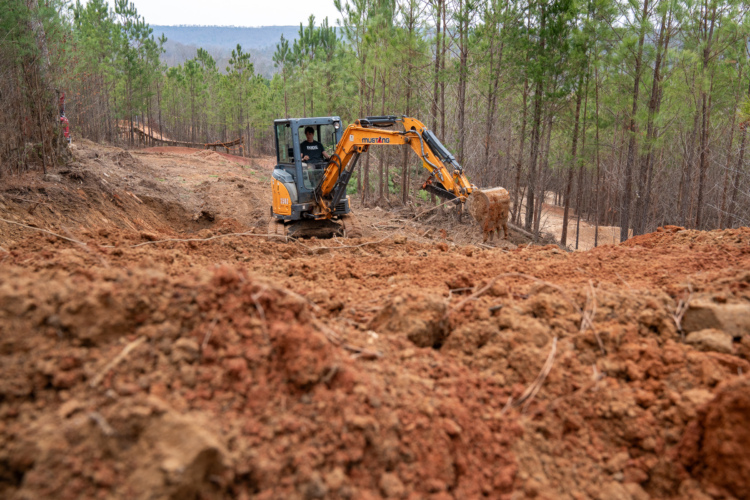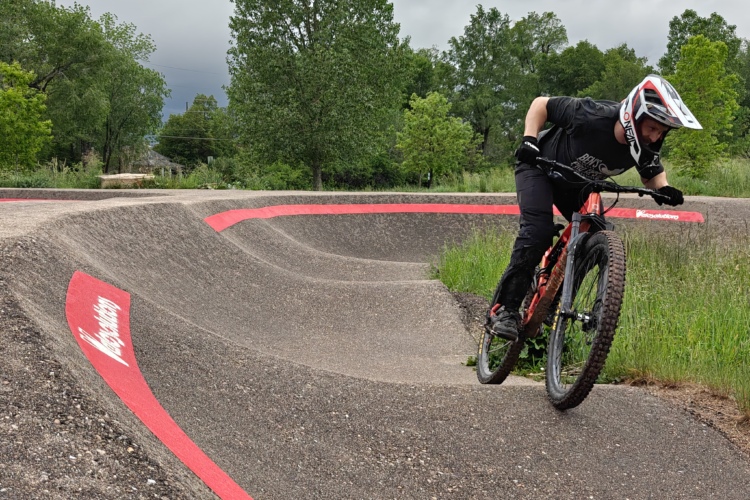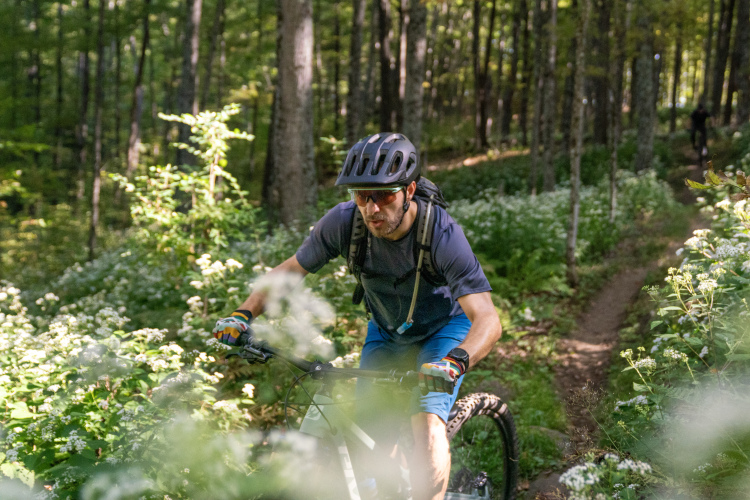
I’ve been mountain biking for decades, and spend most of my time riding regular, non-electric bikes. However, I also ride eMTBs a few times a year, and every time I transition from non-electric to electric, it feels like there’s a bit of a (re)learning curve. Which made me wonder: when it comes to technical skills, is riding an eMTB any different from riding a traditional mountain bike?
To find out, I spoke with Dylan Renn, a longtime mountain bike coach who regularly leads eMTB-specific skills clinics. His take? Going downhill on an e-bike is pretty intuitive for most riders, but climbing requires a different approach.
More bike means more input
With eMTBs, “you have to rely on more controlled movements,” Renn says. “So better bike handling skills for sure.” The added weight of an electric bike means you can’t just muscle the bike around like you might with a lightweight trail bike, which can be a big adjustment for longtime riders.
“Once you slow down, if you don’t have good slow-speed balance, then it’s going to be far more difficult,” he says.
Heavier e-bikes require a bit more steering input, and recalibrating your muscle memory takes some adjustment. Most riders can make the transition pretty quickly, especially for those who regularly switch between their eMTB and non-electric bike.
Climb smarter, not harder
One of the biggest surprises for new eMTB riders? Climbing can still be hard—but in a different way. Though the motor gives you power, it can also lead to traction issues or timing miscues, especially on steep or technical sections.
“A lot of people get stuck in the novelty of the motor pulling them up the hill, and they’re in two to three gears higher than they would be if they were riding up it on an analog bike.”
I’m certainly guilty of this, and the result is that I often stall out at the steepest part of the climb. But why?
Renn offers a power-tool analogy. Imagine drilling a hole in a piece of hardwood. If you push and force the drill bit into the wood, it will get bogged down or start to smoke. But if you spin the drill at maximum speed and back off the pressure, it’ll go much more smoothly. Climbing a steep hill on an electric mountain bike works the same way.
And this is true not just for eMTB, but for regular mountain bikes too. Most of us naturally increase our cadence ahead of a steep climb, and we should do the same even when we have a motor attached.
Spinning a higher cadence also helps keep the motor engaged and smooths out power delivery. That, in turn, makes it easier to maintain traction—especially on loose or technical climbs. In situations where you need extra power, Renn recommends using the rear brake to avoid breaking traction or catapulting yourself into a rock or root in the middle of the trail.
“In certain situations, you might be pedaling into it using power, but then also using the back brake to modulate the power,” like a clutch, he says.

Body position still matters
Downhill body position doesn’t change much compared to a traditional bike, and Renn points out that e-bikes can be more forgiving. “The bikes are going to perform way better downhill, as long as you’re not trying to force it out of things,” he says. “The e-bike inherently is better because it has more mass, and the bike’s just going to roll through stuff easier. It has that natural momentum inherent in the weight of the bike itself.”
While the extra weight of an e-bike helps with stability going downhill, it demands a more conscious body position when pedaling and climbing. “E-bikes turn flats into downhills, and turn uphills into flats.”
With that in mind, on flat terrain, riders may find they need to consciously put more weight than usual on the front end of the bike to help with cornering.
And though an eMTB can turn the climbs into flats, that doesn’t mean you should stay seated the whole way up the hill. When the trail gets bumpy or more technical, a slightly out-of-the-saddle stance is helpful. However, you should rarely stand straight up while climbing on an e-bike because this can cause the front wheel to lift as the motor engages. Making matters worse, riders often over-correct and lean forward to bring the wheel down, which causes the rear wheel to lose traction.
Renn says he usually stays seated on climbs to maintain traction, though never passively. More on that later.
A powerful tool for skill building
E-bikes can be a useful tool for learning new mountain bike skills and improving existing ones. Personally, I’ve found that I’m able to focus on bike handling more clearly when riding an e-bike because my breathing and heart rate are much more relaxed. Renn agrees. “You don’t have the physical fatigue encroaching into it where you’re just trying to get through the situation” and you can put more of a focus on technique.
And because you’re generally riding faster on an e-bike, you can work on improving your reaction times and transitions involved in weighting and unweighting the bike, which is particularly helpful for cornering.
Rather than replacing your regular mountain bike, Renn sees the eMTB as a valuable complement. “You can go out and do skills work on the e-bike and [have a] recovery day,” he says.
Be an active rider
In the end, Renn says the key is to be an active participant in the ride—regardless of which type of bike you’re riding. “You’re not riding passively. You’re not just being lazy through there. You’re doing shit for a reason.”
That advice hits home, especially for those of us who feel a little out of sync — or worse, lazy — when hopping on an eMTB after weeks or months away. The bikes are definitely getting better — lighter, more responsive, and more natural feeling — but there’s still a learning curve, and the e-bike won’t do all the work for you. However, with the right mindset and a few adjustments, riding an eMTB can and should follow the same basic principles involved in riding a regular mountain bike.
Dylan Renn is a certified mountain bike skills coach through USA Cycling, BICP, Betterride, NICA, NASM. In August his company, A Singletrack Mind, is offering a shuttled skills and camping event at Mt. Hood in Oregon.











7 Comments
Jul 29, 2025
Jul 29, 2025
Jul 29, 2025
Jul 29, 2025
Jul 29, 2025
I'm now wondering if some of the modern jump lines I've ridden, which have been built in flatter terrain, are built with e-bike speeds in mind. Doing so would allow builders to build bigger and longer jumps even on moderate downhills, but with the caveat that non-motorized riders probably won't be able to clear them.
Aug 5, 2025
Jul 29, 2025